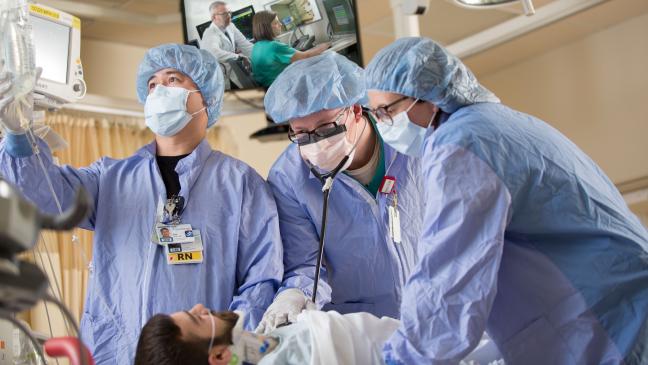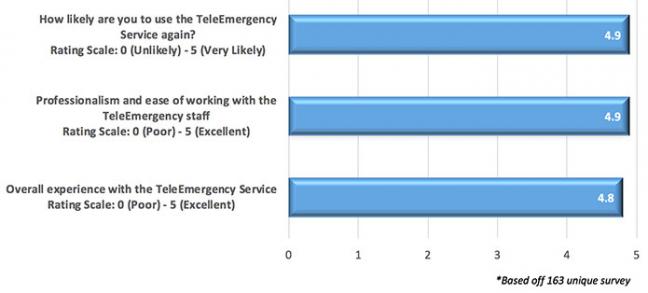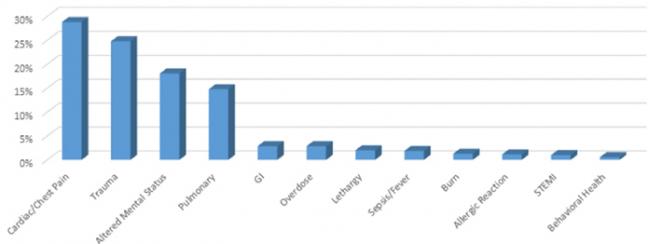Watch this video to learn about our TeleEmergency Care.
With just the push of a button, TeleEmergency can be a life-saving connection
As a leader in clinical services, we are focused on delivering collaborative and integrated emergency care to our partner hospitals. We strive to help deliver outstanding health care to our region, independent of patient location.
TeleEmergency service overview
The 24/7 TeleEmergency service provides emergency rooms with immediate links to board-certified emergency medicine physicians, and experienced emergency nurses, via high-quality, two-way video communication. Our TeleEmergency physicians and staff provide critical-situation services to bedside medical personnel every day of the year. Key services include back-up, patient care, documentation, second opinions, and/or transfer coordination.
Our partner hospitals gain a clinical team that assists in the care of the sickest patients, helping the local team prioritize and guide interventions. We build and sustain effective relationships with Emergency Department nursing staff and providers, utilizing the hospital's information system, and integrating clinical workflows, pathways, and protocols.
Patients are evaluated, managed, and treated in real-time collaboration with the local attending physician or associate provider. This approach enhances emergency care while leveraging limited bedside nurse and provider resources.
Our seasoned emergency physicians and nurses are skilled in the dynamics of working collaboratively with the hospital's medical staff. TeleEmergency physicians must be licensed and credentialed in all states/hospitals where services are provided.
TeleEmergency responsibilities
In addition to providing support for patients requiring emergency medical care, our TeleEmergency team provides the following services:
- Support and coordination for credentialing/privileging
- Program implementation: An experienced and multi-disciplinary team comprising a project manager, clinicians, and technical professionals delivers a wide range of services throughout the planning and implementation process. A collaborative project plan, developed after contract signing, specifies responsibilities and timing for each implementation task.
- IT hardware/software installation, set-up, and ongoing support
- assistance with dedicated circuit connectivity, network configuration, equipment delivery and set-up
- annual cleaning and maintenance of telemedicine equipment
- 24/7 support for technical issues.
- Program training: Clinical training is delivered to your staff to assure confidence in the TeleEmergency service and the partnership between us and your hospital.
- Additional educational offerings for hospital staff
TeleEmergency benefits
Physicians and Associate Providers have a support resource that provides:
- Rapid response to patient needs with guaranteed physician and nursing staff availability, 24/7/365
- Peer consultation and increased comfort with clinical decision-making
- Assistance with arranging transfers
- Reduced professional isolation in rural settings
- An additional "set of eyes" for complex, critically ill, or more challenging cases
- Reduced on-call requirements and burnout
- A range of educational components available for your staff may include case reports, mock codes and simulations, lectures and conferences, clinical guidelines, additional topics by request
Nurses have immediate access to certified emergency RN colleagues allowing:
- Rapid response to patient needs
- Increased focus on patients – nurses stay at the bedside to provide care while the TeleEmergency Service provides documentation
- Increased nursing satisfaction and retention
- Nursing consultation for use of vasopressors, medication compatibility, drip preparation, equipment, code timing, or other bedside questions
- A range of educational components available for staff may include case reports, mock codes and simulations, lectures and conferences, clinical guidelines, additional topics by request
Advantages of our TeleEmergency program
Please expand the following topic areas to learn more about the advantages of partnering with our TeleEmergency program.
Financial and Quality Impact
TeleEmergency contributes positively to finances, market position, and staffing management through:
Improved financial performance
- Reduction of transfers
- Reduced staffing costs, decreased need for locum tenens
- Improved physician life balance, retention, and recruitment
- Increased ED capacity resulting from greater throughput
Improved quality measures and outcomes
Competitive market advantage
Educational Resources
Earn CEUs for CME and CNE
Continuing Education portal provides 24/7/365 access to online education sessions
- Clinical Staff can obtain CME/CNE credit from a desktop, laptop or smart phone
- Sessions are usually 60 minutes or less
- Certificates are issued after successful completion of course
Conduct Mock Codes
The unique bird's eye perspective TeleEmergency provides creates the ideal opportunity to run mock codes leveraging our clinical staff to your benefit.
- Utilize TeleEmergency access to conduct mock codes
- Receive collaborative feedback from clinical staff as observers or participants
Technology
TeleEmergency has done the work of researching, installing, and supporting best-in-class technology, establishing equipment and connectivity standards to bring reliable service to your Emergency Department. Our standard is to connect your high acuity and trauma emergency rooms to the TeleEmergency service.
Essential equipment and connectivity at each partner site includes
- Call button on the wall to contact TeleEmergency
- Fixed, hard-wired:
- High-definition video equipment with high zoom capability installed in both serviced room (typically trauma and high acuity rooms are selected)
- High definition monitor installed in each wired room
- Ceiling microphone installed in each serviced room
- Network circuit to connect your location to our TeleEmergency service hub
Hospital Satisfaction
Feedback from partner hospital clinical staff
Below are survey comments, regarding satisfaction with our TeleEmergency services, received from partner hospital clinical staff.
- "It is great having Dartmouth's RN documenting and capturing the details of the encounter and calling times."
- "Reassurance of having a second set of eyes observing"
- "I like having access to another nurse to ask questions and get validation"
- "Having the Dartmouth doctor reading the EKG and sharing their analysis was helpful"
- "Suggestions for treatments, recoding of VS and procedures, calling report"
- "The transfer process is a valuable resource that keeps me by the bedside and off the phone"
- "The ability to conduct transport MD consults"
TeleEmergency partner hospital satisfaction
General Questions
Who makes the decisions on patient care?
Your local provider makes all final decisions regarding patient care. If requested, your provider and the TeleEmergency hub MD will collaborate to determine medical status and treatment plans. In all circumstances, the TeleEmergency care team will communicate plan of care with your clinical staff.
How can out-of-state providers deliver care to patients at a hospital in another state?
All TeleEmergency physicians are licensed and credentialed in all states/hospitals where services are provided and all TeleEmergency nurses are licensed in each state where the service is offered.
How will ordering of tests and medications work?
Clinical staff will have read-only access to your EMR. All orders will be given verbally, followed by a signed, faxed order that can be scanned into the patient record.
How will our local provider work with the TeleEmergency provider to deliver care?
The service is a collaborative effort. The local team determine level of involvement by requesting type of support needed – i.e. Nurse, Physician, Transfer Support, for each encounter.
Can TeleEmergency physicians make decisions about treatment in absence of a local provider?
Yes. They are credentialed and privileged in your state and hospital. They have EMR access and can view, vitals, medications, lab results, and images over a secure connection. However, your local provider must see the patient prior to discharge.
What kinds of things can TeleEmergency Physicians and Nurses assist us with?
TeleEmergency staff are available to support you on many levels, to include:
- Physician guidance (from consult/second opinion to managing complete care), procedural guidance (intubations, chest tubes, code timing) and patient transfer coordination
- Nursing documentation and support (trauma flow sheet and code documentation), assistance with running codes and very sick patients, medication questions (drip rate calculation, compatibility).
Will the TeleEmergency hub know how our ED functions?
Yes. During the implementation process our team will work with you to identify information specific to your hospital, such as:
- Available equipment – we know where your EZ IO and your Zoll are located
- Available medications – we know your formulary and won't order what you don't have
- Lab capabilities – we know what tests you can run on site
- Typical transfer patterns so that we can coordinate, keeping you at the bedside
- Contact information for providers, nurses, ancillary staff, so we can call in your teams if needed (i.e. code, lab, x-ray, mass casualty)
Why are cameras necessary?
Cameras allow the TeleEmergency team to fully participate in patient care. The TeleEmergency staff only view patients when invited to do so. When activated, the camera turns to face the patient. When the camera is off, it rotates to face the wall. No portion of the video encounter is ever recorded.
How is the patient's private health information protected?
PHI is not released to anyone other than those involved in patient care. No recordings are made using TeleEmergency cameras or microphones. Patient information is shared only across secure connections.
Will there ever be a time when you can't take our call?
Though rare, triage does happen, much like in your own ED. If your patient is low acuity and you are comfortable, you may be asked to log off to make room for a higher acuity patient. You can call back later for additional assistance if needed.
Will the patient receive a bill for this service?
Patients are not billed for any services provided by TeleEmergency. Your facility pays a monthly fee for the service, similar to a gym membership. The fee does not change based on how much or how little the service is utilized.
Outcomes and statistics
TeleEmergency Service Chief Complaint
Case study
A minimally responsive 9-month old was brought to a critical access hospital Emergency Department.
The local ED team engaged the TeleEmergency physician and nurse at the time of patient arrival. Over the next three hours, they supported the bedside team with early diagnosis, resuscitation, procedural assistance, and empiric and definitive therapy. The TeleEmergency team also coordinated acceptance by the Dartmouth Hitchcock Medical Center (DHMC) PICU team and, once the weather cleared, transport by rotor wing transport.
The child was ultimately discharged from DHMC 10 days later, healthy, happy, and with no complications.
Partner testimonials
I have used TeleEmergency for various situations including trauma, codes, unstable patients... It has been very helpful to have an extra pair of eyes and sometimes a second opinion, just to reassure me or help me. A case may call for meds I don't use often, such as pressors, and it's good to compare notes.
TeleEmergency is also helpful with help finding a bed and arranging transport. I find the system very helpful. A bit like a second opinion or a consult. I have never felt judged or under a microscope. The help has been non-judgmental and genuine. I would strongly encourage others to use tele ED. We don't use it every day but when we do...it's great!Dr. Medric LeBlanc, Weeks Medical Center
“I was working at one of my community hospitals on New Year’s Eve when a 74 y/o woman on Coumadin arrived as a stroke alert via EMS. I called the TeleEmergency service prior to her arrival. By the time she was in the resuscitation room, the TeleEmergency nurse was already documenting and pulling up her past records at our hospital and DHMC, our closest tertiary hospital. The patient had a traumatic intracranial hemorrhage due to a trip and fall the previous night. Her resuscitation was complex, but incredibly smooth. The TeleEmergency team performed all of the nursing documentation, double checked compatibility of medication infusions (K-centra, mannitol, Keppra, propofol, nicardipine) and did all of the physician communication with DHMC for her transfer. The communication with DHMC often takes us 20-45 minutes of physician time away from the bedside. The TeleEmergency service is invaluable just for the ease of transfers alone, let alone all the other services provided. By the time I had evaluated, resuscitated, and intubated the patient, DHART (our local air ambulance) was in the air and we had an accepting physician from DHMC. She received a smooth, quiet, and efficient resuscitation and transfer thanks to our local ED team as well as the TeleEmergency team.
I had a very similar case at a different community hospital the following week and the resuscitation was not nearly as smooth due to a lack of nursing resources. If we had your TeleEmergency services at that second hospital, I am sure that my patient there would have received much more efficient and safe care. Thank you for providing this valuable service for our patients, and our ED staff (both nurses and doctors).Dr. Alison Kapadia, Emergency Medicine physician
Contact information
For more information about our TeleEmergency services, please contact:
Dawn Castles
Director Telehealth Administration
Email: sirima.d.angsuwan.castles@hitchcock.org
Phone: 603-650-1361


